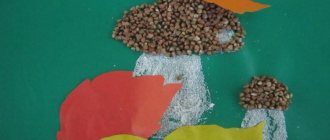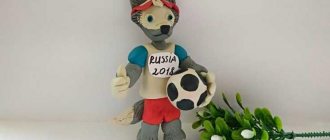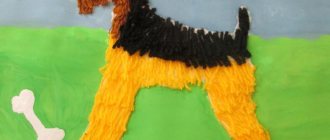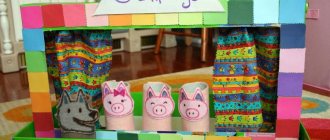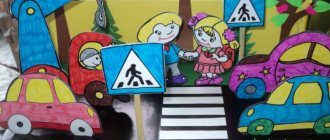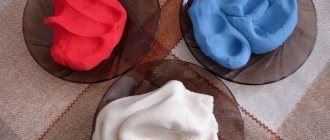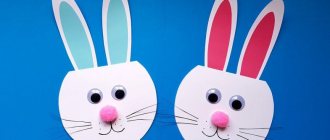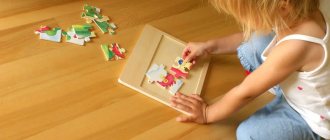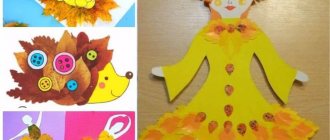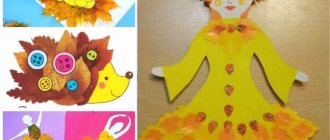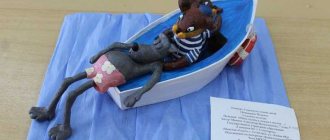Fairy tales are limitless material for work. To awaken an interest in creativity in young children, it is better to make crafts based on the themes of children's stories.
This will hold the child’s interest for a long time, and while working, you can read fairy tales with your baby.
The child’s imagination will run wild, and it will be easier for him to make figures of certain characters.
Materials for work
The set of materials depends on what kind of craft will be made, because they have their own characteristics. The main materials will be plasticine, glue, colored paper, paints and brushes. Materials for crafts can also be natural materials: acorns, dried flowers and leaves.
Craft ideas based on children's fairy tales
There are a huge number of ideas for creations on fairy-tale themes; you can depict individual characters, as well as entire scenes. Crafts can be either flat in the form of paintings or three-dimensional with small sculptures.
Plasticine Alyonushka and little brother goat
Based on the fairy tale “Sister Alyonushka and Brother Ivanushka,” where the main characters were the girl Alyonushka and her brother, who turned into a kid, you can make a composition from plasticine.
To create a picture you need to take colored cardboard of blue or cyan color, indicating the sky:
- Prepare in advance an image of Alyonushka and Ivanushka, turned into a kid, so that you can visually see the picture.
- To make panels, take plasticine of different colors or salt dough. If you take the dough, then prepare more paints and brushes in advance.
- Looking at the picture, you sculpt the figures of the characters.
If you are making a craft from colored plasticine, then the colors are selected in accordance with the picture.
If you decide to sculpt figures from salt dough, you need to make the material itself. To do this, take flour, salt and cold water. Water 200 ml, flour 300 ml, salt 300 gr.
If you plan to make a very small product, then you can take fewer ingredients, the main thing is to maintain the proportions, the same amount of flour and salt, and less water. The dough should have the consistency of plasticine.
Rocker with buckets made from popsicle sticks
Based on the famous fairy tale “Emelya and Pike,” you can create an interesting composition with wooden ice cream sticks, depicting a rocker and buckets:
- You need to make two small tubes, glue thick cardboard so that you get a small roller. Cover them in a circle with ice cream sticks on top.
- Cut narrow strips from pieces of leather or thick brown fabric and tie them around the bucket in two places, top and bottom.
- Next, you need to make a rocker from a piece of leather cut in a semicircle.
- Wrap the leather with wire and secure the edges of the wire to the edges of the buckets so that the composition looks holistic.
- You can make “legs” underneath the buckets - attach a wire tightly wrapped in a spiral, and you can wrap a rope around it on top for greater aesthetics. And at the bottom, fashion bast shoes from brown plasticine or colored salt dough.
Paper bun applique
You can make a simple applique out of colored paper even with the youngest children. To do this, you need to stock up on paper glue, colored paper, cardboard, brushes and scissors with rounded edges if you are doing this with a child:
- You can take a picture from the fairy tale Kolobok for help and try to reproduce this picture from colored paper.
- Cut out the bun itself in a circle from yellow paper and create surrounding objects - a Christmas tree or a tree, a green background that will represent the grass and the house from where the bun escaped.
- Initially, you can take blue cardboard so as not to cut out the sky background separately.
- Glue everything with paper glue. It is better to spread the glue with a brush so that there are no unevenness on the application. It will be interesting for the child to do this work, because he will see how a whole picture comes to life from ordinary pieces of paper.
Pasta bun
A three-dimensional Kolobok figurine can be made from a food product - pasta. No matter how unusual it may sound, you can make a lot of different products from pasta, not only edible ones:
- To make a Kolobok, you need to inflate a medium-sized balloon to make it easier to create a ball shape.
- Next, it’s a matter of technique, you need to take pasta, preferably in the form of stars or flowers, and good quality glue that can glue such products together - PVA glue or superglue.
- Then the pasta is glued together in the shape of a ball until it forms a hemisphere.
- When the Kolobok is almost ready, you will need to burst the ball and pull it out until the entire space is sealed.
- Next you need to add the ball shape. You can glue eyes, a nose and a mouth cut out of colored paper to the finished bun.
- This work can decorate your kitchen or child’s nursery.
Craft “Frog Princess” made from salt dough and colored paper
The next work on the basis of which the craft will be made is “The Frog Princess”. The composition will be voluminous from salted dough, the recipe for which is described at the beginning of the article. Colored paper will be used here.
Before making this composition, it is better to read this fairy tale with your child so that he can imagine who the frog princess is and why she is famous.
To create a three-dimensional figure, it is better to take images of the frog princess to make it easier to recreate the shape:
- The backing for the composition should be made of blue cardboard - this will be water.
- It is better to cut out the water lily leaf under the frog from a thick green sheet of paper.
- Before sculpting, you need to prepare acrylic paints, with the help of which the main character will be painted.
- Frog parts are molded separately from salt dough, and a figurine of a sitting frog is molded from them.
- The frog's body is painted green, the belly is a light yellow tint.
- An arrow, which was shot by the famous Ivan Tsarevich, is placed in the frog's legs.
- A crown is attached to the head of the “princess”. A reed made of colored green paper is glued around the edges of the island with a figurine.
- Characteristic reed inflorescences are made from toothpicks and plasticine.
You and your child will love the resulting scene; it will bring an element of a fairy tale to the children's room.
Volumetric craft on the theme of the fairy tale “Turnip” made of cardboard
You can make almost an entire “theatrical” scene for the Russian folk tale “Turnip”. Based on the famous work, the whole family tried to pull a turnip out of the ground, and only the mouse was able to exert maximum impact, and thanks to it, the turnip succumbed.
To make the work, you need to take thick cardboard, preferably from an old box. On this substrate, make an impromptu vegetable garden - cut out grass from green paper and glue brown paper to represent the ground.
The turnip itself and the characters can be cut out of cardboard, made into cardboard stands in the form of cones and placed in the sequence in which they are described in the work. Or sculpt them from plasticine.
You can create an environment near the characters - sculpt a house and attach trees cut out of cardboard. It turns out to be a whole “live” scene.
Winter hut made of cotton swabs
A winter hut made from cotton swabs will be a very interesting and beautiful product, especially during the New Year holidays.
For production you will need hygienic cotton swabs, glue and cardboard.
This house is made according to the principle of making a house from matches. The sticks are folded parallel to each other:
- A small drop of glue is applied to the place where the cotton wool begins to run out.
- Next, sticks are placed on top, positioned perpendicular to the first sticks. They are held together using glue, thus creating the entire house.
- After the frame is created, the roof is made.
- You can make it up by putting the sticks next to each other and gluing them together with the body. But it is very difficult and you need a lot of glue to keep the sticks in place. You can simplify the situation and fold a thick sheet of paper in half, it will represent the roof.
- Cotton swabs are glued tightly to each other on top of it. The beautiful snow-white house is ready!
On top you can decorate it with rhinestones, rain, beads, snowflakes or stars and the holiday atmosphere will enter your home along with this beautiful craft.
Miracle tree made of buttons
A Magic Tree made of buttons can become a beautiful picture that decorates any, even the most modern and fashionable apartment. In many fairy tales there are good helpers - magic trees. You can recreate the same helper and talisman for your family from ordinary buttons.
You can depict it on a uniform background, or you can create an all-season look using colored cardboard or colored paper. To do this, you need to take a large A3 sheet and visually divide it into four parts with a pencil. Next, cut out 4 different backgrounds from colored paper for winter, spring, summer and autumn.
Glue the colored rectangular pieces onto the surface, it will be divided into several parts. Then you can cut out a tree trunk in the middle from brown construction paper, or you can paint it with acrylic or any other thick paints.
Then buttons are selected according to the color of the season: for winter - blue, white and light lilac, for spring - light pink, light green, light yellow. For summer - bright and dark green and for autumn - orange, red and bright yellow. They will represent the leaves of the tree.
Next, the buttons are glued evenly in accordance with the time of year on the background. The result is a very bright and unusual picture, reflecting the changing seasons.
Pushkin Goldfish made of beads
Well, what would we do without the fairy tales of the great Alexander Sergeevich Pushkin. A wonderful and unusual character in his tales is the goldfish. You can try to create it together with your child.
If you have the skill of beading, you can weave it, but with children it is better to use a simpler option, making the craft by gluing it onto a flat surface. For production you will need: blue or light blue cardboard, yellow, orange and golden beads, PVA glue:
- On cardboard with a pencil you need to draw the silhouette of a fish.
- Next, use orange beads to lay out the main body of the fish, then the tail can be depicted with yellow beads and the tip of the tail highlighted in gold.
- The upper fin should be larger in size, it can also be made by combining two colors - yellow and golden.
- On the head of the fish, mark it with black or dark blue beads, or better yet, with a button for its eyes. It should be larger than the main beads from which the picture is made.
- On the sides of the fish, cut out algae from colored cardboard and place them on the sides.
The finished painting can be framed, it will be a very beautiful “fairy-tale” work.
Drawing competition “An old, old fairy tale”
Surely in your closet there is an old thick book of children's old fairy tales, worn out by time and the hands of several generations of the family. Oh, how children love such fairy tales about a cocky wolf, a cunning fox, a cowardly and at the same time brave hare, a grumpy old woman... Old fairy tales are our history, culture, traditions. We will be glad to receive children's illustrations for such fairy tales!
All competitions
Home page
DIY crafts made from natural materials
Volumetric compositions and applications can be made from natural ingredients: dry leaves, cones, grass. You can make an old forest man from a pine cone and dry twigs:
- Take two cones, one longer, it will indicate the character’s torso, the other small, more rounded one will represent the head.
- The cones are glued to each other, small on top, extended underneath with the narrow side down.
- From the bottom to the long cone, two small branches are glued with PVA glue - the legs of the forest tree. They are “shoeed” with bast shoes made of brown plasticine. And eyes are glued to the top round cone; you can buy them at a sewing store or make them yourself from plasticine.
- The next step will be the forest tree’s hat, it can be made from a dry leaf of a tree or from birch bark, it needs to be folded into a cone and attached to the top of the cone.
- The old man's mouth is sculpted from a thin strand of plasticine.
- The woodsman’s hands are like tree branches, proportioned to the right size. In one of the “hands” you need to glue another branch as tall as the character. This is the staff of a magical forest dweller.
The unusual character is ready.
From dry leaves and twigs you can continue the composition and create a surrounding forest. This craft can be taken to a kindergarten competition dedicated to fairy tales; it will delight children and teachers.
Application “The Fox and the Gingerbread Man”
The famous cunning Fox and Kolobok, who left his grandfather and grandmother, can be personified on a flat surface. Doing this type of creativity with your child develops their imagination very well.
For production you need cardboard, paper, paints, brushes, glue. To make drawing easier, you can take a ready-made picture of a fox and a bun and transfer the outlines through a transfer onto cardboard.
And you can also paint the background in the picture in advance, so as not to stain the characters with paint later. After the background has dried, you can glue wheat groats along the silhouettes of the characters. The world around the Fox and Kolobok can also be made three-dimensional, for example, trees and grass can be covered with grain.
After everything is ready and dry well, you can start painting. This must be done carefully so as not to touch unnecessary elements. After the paint has dried, the work is ready! Can be framed and hung on the wall.
Thus, we can come to the conclusion that, using various materials, imagination, ready-made pictures that you can focus on, you can create your favorite character from any fairy tale.
The child will be happy, the children's room will be filled with cozy and unusual compositions that will surprise your guests. It is very useful for children to engage in this type of activity, as they develop imagination, logic and hand motor skills.
You can experiment with different materials, complement them according to the logic of creating certain compositions, bring in something new and unusual, perhaps the child himself will suggest new ways.
You need to listen to your child, because children do not have a blurred view of things, like adults, and they can quickly find new approaches to solving a particular problem.
Russian fairy tales are distinguished by their unusual characters, they teach kindness, helping each other, not being greedy, not being afraid to go on adventures, and, of course, that good triumphs over evil.
Journey to the Land of Fairy Tales lesson plan in fine arts (art, 1st grade) on the topic
Journey to the Land of Fairy Tales
Fine art lesson. I class.
T.S. Zadesentets, teacher of fine arts of the highest category at the Pokrovskaya Primary Secondary School of the Oktyabrsky District. Primorsky Krai.
The lesson is held at the end of the second quarter.
Goals: To develop in children the ability to identify in artists’ illustrations the means of conveying the fabulousness and unusualness of what is happening; learning to portray a fairy tale cockerel; improve the ability to use gouache painting techniques; development of fantasy and creative imagination.
Equipment: gouache, colored paper, brushes (thin and medium), Russian folk tales, illustrations by Yu.A. Vasnetsov and E.M. Racheva.
During the classes:
- Organizing time.
- State the topic and purpose of the lesson.
- One, two, three, four, five and we, guys, are with you at an exhibition of literary works (on the board there are books of Russian folk tales). Who knows what these literary works are called? Stand up and say in chorus (relay race in rows, name Russian folk tales). For a month now we have been traveling through a wonderful fairyland. What heroes have we met along the way? (wolf, kids, white-sided magpie, bun). And wonderful storyteller artists helped us in this (showing the presentation “Russian Folk Tales” with illustrations and portraits of artists). So today we will go with you to a fairy tale. What qualities do we need when traveling? (children's answers). And here the heroes themselves are rushing to meet us (showing a scene from the fairy tale “The Cockerel - the Golden Comb”: Meeting of the Fox and the Cockerel). What is the name of the fairy tale? (children's answers). And again, artists Yu.A. will help us draw fabulous pictures for a new fairy tale. Vasnetsov E.M. Rachev (showing the presentation “Illustrations by artists for the fairy tale “The Cockerel - the Golden Comb”).
Questions for students:
— Tell us what we see in the illustration?
- What background is the cockerel depicted against?
- Do you think this is a fairy tale or a real picture?
— Tell us what is closer and what did the artists depict next?
— Let’s compare the images of cockerels and Yu. Vasnetsov and E. Rachev.
— What techniques do artists use to convey the fabulousness of what is happening?
- Practical work of students.
Work in pairs. Make a cockerel out of geometric shapes.
- Clap your hands for whoever does it first. Help those who are having difficulty. Our task: to turn the cockerel into a fabulous one.
Questions for students:
— On which sheet is it convenient to depict a cockerel? In color or white?
— What is the most convenient way to place the sheet? Vertical or horizontal?
— Look at the pictures of three cockerels, which are located in different parts of the front wall of the classroom. Which rooster did you like? (on the sheets there are images of a small, medium and large cockerel).
Physical education lesson (led by student):
Cockerel, cockerel - golden comb,
Oil head, silk beard,
Why do you get up early? Do you sing loudly?
You don’t let Vanya sleep.
(student shows movement while reading verse)
The teacher reminds children of the techniques of working with a brush: using an inclined movement of the brush to obtain wide stripes and strokes, a vertical position for drawing with the end of the brush, shows how to dilute and mix gouache paints, evenly cover the desired surface with them, change the directions of strokes according to the shape. Draws children's attention to beautiful color combinations in their drawings, makes sure that students boldly use color to create fairy-tale images.
At the end of the lesson, students themselves evaluate their drawings, noting who best reflected the fabulousness of the events and by what means they managed to achieve this; who managed to convey space in the drawing and due to what; who has the layout of the sheet and the size of the image consistent with the design; Which picture has the most expressive color scheme?
The best drawings are selected for the exhibition.
When summing up the results, I encourage students to have an emotional attitude towards the image process, accuracy, activity, and independence in completing the work.
The guys line up at the board with their drawings. I call the student and give him a stick:
- Imagine that this is a magic wand. Show it which drawing you liked, so you yourself have turned into this fairy-tale hero. And on his behalf, evaluate the drawings of your comrades.
(during the lesson, the song “Come, Fairy Tale” from a cartoon familiar to children is played).
